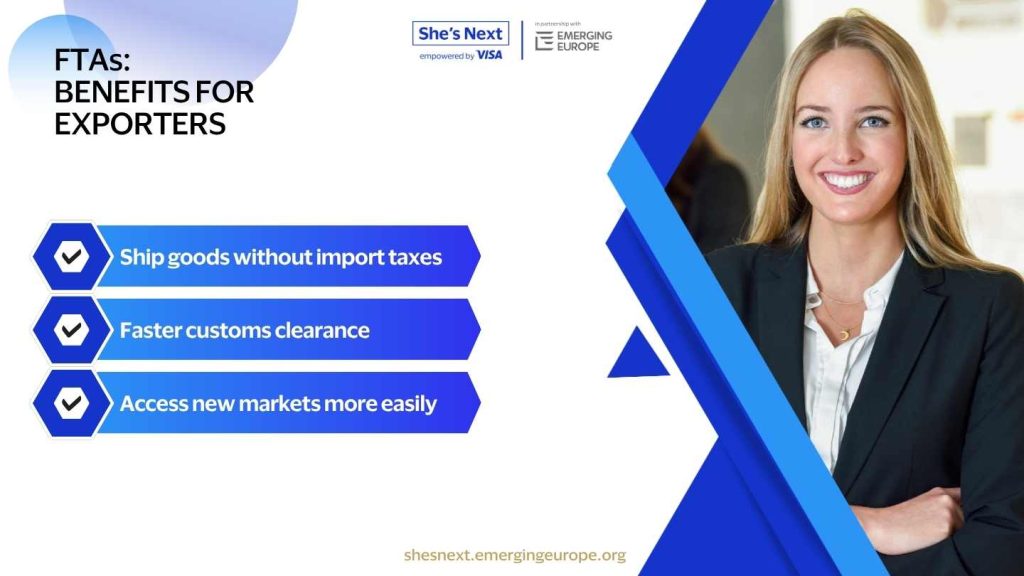
Understanding free trade agreements: What are FTAs and how do they work?
Free Trade Agreements (FTAs) can be game changers for small and growing businesses looking to scale internationally. They open doors to new markets by reducing tariffs, simplifying regulations, and improving trade conditions. But to benefit, you need to understand how they work.
In this article—the first in a two-part guide—we’ll unpack what FTAs are, explore their different types, and explain how they make cross-border trade easier and more cost-effective.
What are free trade agreements?
A Free Trade Agreement is a formal pact between two or more countries to simplify and promote trade. Unlike standard trade deals, FTAs go beyond basic cooperation—they actively reduce or remove tariffs, quotas, and restrictions on goods and services.
What this means for exporters: You may be able to ship goods without paying import taxes, face fewer customs delays, and access new customers faster.
FTAs typically cover:
> Tariff reductions or eliminations on goods
> Customs and border facilitation to speed up clearances
> Regulatory cooperation, ensuring mutual recognition of standards
For entrepreneurs in Georgia, Kazakhstan, or Moldova, tapping into these agreements can significantly reduce the cost of doing business abroad—especially when targeting European or East Asian markets.
Different types of free trade agreements
There’s no one-size-fits-all model. FTAs come in several forms.
Bilateral agreements: These are between two countries.
Example: The EU–Vietnam FTA offers Vietnamese exporters access to EU markets with reduced tariffs. A similar agreement with Central Asian nations could have the same effect.
Multilateral agreements: These involve multiple countries and are often broader in scope.
Example: The CPTPP includes 11 Pacific Rim countries and streamlines trade across borders.
Regional trade agreements (RTAs): These involve countries from a specific region working together to boost trade.

Example: The European Economic Area (EEA) and Eastern Partnership agreements between the EU and Armenia, Georgia, or Ukraine.
Why this matters: The type of agreement affects what products qualify, which countries you can access, and how your goods are treated at borders. For instance, Armenian food producers may find fewer regulatory hurdles when exporting to the EU thanks to bilateral cooperation agreements already in place.
How do FTAs work in practice?
Tariff elimination
One of the most immediate benefits is reduced or eliminated tariffs. This can lower costs for both you and your customers—giving you a price advantage in competitive markets.
Rules of origin (ROO)
To benefit from tariff reductions, your product must ‘originate’ from an eligible country. This means it was either made there or had enough value added there.
You’ll need to provide a certificate of origin to prove it.
Customs simplification
FTAs often come with improved customs procedures—less paperwork, standardised documentation, and faster clearances.
Example: Businesses exporting machinery from Ukraine to Poland under the EU Association Agreement can benefit from simplified customs processing.
Free Trade Agreements aren’t just trade diplomacy—they’re real tools your business can use to compete globally.
By understanding what FTAs are and how they function, you can position your business to save money, increase efficiency, and expand more confidently into international markets.
In Part 2, we’ll explore how to maximise the benefits of FTAs—from finding the right agreement to navigating rules of origin and working with customs brokers.
New Free Courses — Made for Ambitious Women Entrepreneurs!
It’s time to grow smarter, adapt faster, and take your business global.
Explore two powerful courses available exclusively to She’s Next members:
The Reinvention Masterclass for Start-up Founders
Beyond Borders: Building for Global Success
Enroll today — it’s free!





